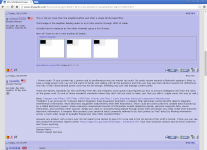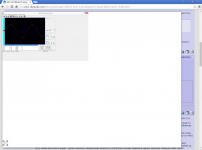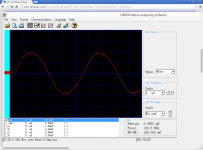Back to power cables, has any one hooked up a LISN (https://en.wikipedia.org/wiki/Line_Impedance_Stabilization_Network) between the electrical supply from the building and the unit under test to see if the problem might be a resonance in the buildings wiring?
Yet, where are the measurements?
Jan
I have the equipment still in storage... did it years ago. For your entertainment, I could do it again I suppose.
I recall the field radiated from speaker cable (music source) was easy to measure 3 feet from cable. I watched the meter needle kick to the bass notes (higher current flow).
One of the reasons I have so much test equipment is curiosity and to learn what 'things' really, actually do in a system. In this case, afterwards, I went to shielded cords/cable.
Thx-RNMarsh
Last edited:
What I mean is that without a LISN you cannot properly compare different power cables.
true ... you need a standard. Not sure the LISN is the appropriate model for audio. But something which captures the 20-20KHz freqs in the comparison.
In my case, I wasn't looking for which one to purchase or best one etc. But to just reduce what I had as much as possible.
-RM
Last edited:
escatology. 🙂
Man, this seems closer and closer to the truth when we're talking about power cables.
Here's an easy test though -- pick the worst time of day for your area WRT local power crud, and run a HF IM test. If hash isn't really showing up on your plots then it's probably not really there, no?
WOW! The new BenchMark DAC-3 is way better (listening-wise) than the -1 or -2 previous model.
The DAC 1 was good. The DAC-2 was slightly better. But the DAC-3 is a whole 'nother thing. Truly, Excellent now.
THx-RNMarsh
The DAC 1 was good. The DAC-2 was slightly better. But the DAC-3 is a whole 'nother thing. Truly, Excellent now.
THx-RNMarsh
Last edited:
For power tests, you can use (I do) a wideband inductive loop around the wires and send the pickup signal to a spectrum analyzer to see and measure the freqs on the line.
THx-RNMarsh
THx-RNMarsh
I recall the field radiated from speaker cable (music source) was easy to measure 3 feet from cable. I watched the meter needle kick to the bass notes (higher current flow).
Thx-RNMarsh
I can accept that. I have spend hours receiving stray emissions from PC-to-display and keyboard-to-PC in military facilities at 100m outside of the fence, to the point that we could hand over email printouts to the consternated commander.
And I noticed that you switched from mains cables to speaker cables.
Jan
Thanks
If we left-click on the enlarge arrow left lower corner, the image goes full screen. No need for anything more elaborate.
George
Attachments
For power tests, you can use (I do) a wideband inductive loop around the wires and send the pickup signal to a spectrum analyzer to see and measure the freqs on the line.
"A wideband inductive loop around the wires", like in "coaxial"? And what would that measurement show? The resulting magnetic field is (or close to) zero at all frequencies.
Wolfram Demonstrations Project
Man, this seems closer and closer to the truth when we're talking about power cables.
Here's an easy test though -- pick the worst time of day for your area WRT local power crud, and run a HF IM test. If hash isn't really showing up on your plots then it's probably not really there, no?
I failed my own joke. I should have bolded it as escatology.
WOW! The new BenchMark DAC-3 is way better (listening-wise) than the -1 or -2 previous model.
Yes, I would say it's clearly better than DAC-1. Never tried a DAC-2. But, as I said before after getting a DAC-3, I'm still not sure it's transparent. It's certainly closer though. Found a good home for the DAC-1 too, somebody who will make good use of it.
I'm glad that somebody, somewhere is improving digital playback. '-) According to some, it should be impossible, however, my OPPO 105 apparently will become more and more obsolete as digital progresses.
I would like to point out something that I am attempting to do here on this tread, and have tried to do for more than 10 years. I am trying to keep peoples' response to audio component sound quality open for discussion. I also would like to promote more serious measurement efforts that actually give us more insight as to why we appear to hear better than most measurements show significant difference.
Measurements are not always taken very seriously, when they go outside the typical norms such as IM or harmonic distortion.
Historically, I remember when Walt Jung did a long research article on SID with two other guys. One was a former CAL Berkeley classmate of mine who then worked at Sound Technology, and another guy who worked at Signetics (I think). Both got cold feet about publishing this excellent article at the time due to pressure from mid fi manufacturers, who did not like to 'rock the boat'. These 'heads of industry' didn't think much of me, either. Today, if we read this series of articles, most of us would say something like: 'Of course, it should be obvious'. Well it wasn't back in the late 70's, but that is how we progress over the decades.
Measurements are not always taken very seriously, when they go outside the typical norms such as IM or harmonic distortion.
Historically, I remember when Walt Jung did a long research article on SID with two other guys. One was a former CAL Berkeley classmate of mine who then worked at Sound Technology, and another guy who worked at Signetics (I think). Both got cold feet about publishing this excellent article at the time due to pressure from mid fi manufacturers, who did not like to 'rock the boat'. These 'heads of industry' didn't think much of me, either. Today, if we read this series of articles, most of us would say something like: 'Of course, it should be obvious'. Well it wasn't back in the late 70's, but that is how we progress over the decades.
And I noticed that you switched from mains cables to speaker cables.
Jan
Not intended... Both is intended. shield both.
-RM
There are many ways to test for noise on/in/from cables. A CT or Current transformer, an inductive probe and even wide band transformer.
Just what is it you want to see? The speaker wire field radiated used a TriField meter. calibrated at 60Hz. The fields of interest were the magnetic field with this unit.
THx-RNMarsh
Just what is it you want to see? The speaker wire field radiated used a TriField meter. calibrated at 60Hz. The fields of interest were the magnetic field with this unit.
THx-RNMarsh
This morning I took out the DAC 2 and replaced it with the DAC 3 without telling my lady. I started playing music and as she walked by the speakers, she paused and listened and said, you can hear the string vibration. She did not know I even bought the DAC3.Yes, I would say it's clearly better than DAC-1. Never tried a DAC-2. But, as I said before after getting a DAC-3, I'm still not sure it's transparent. It's certainly closer though. Found a good home for the DAC-1 too, somebody who will make good use of it.
This is good example of people who are very familiar with a system over a long time period and hear a change easily .... but probably would not be able to tell better than 50-50 between the two in DBLT.
her comments afterwards all confirm my listening impressions also that the DAC 3 is a significant audible improvement.
-RM
Last edited:
Not intended... Both is intended. shield both.
So I take it you found significant electric fields, not just the magnetic field measurements you were talking about earlier?
Also, how are you grounding your shields, at both ends, or which end?
- Status
- Not open for further replies.
- Home
- Member Areas
- The Lounge
- John Curl's Blowtorch preamplifier part II


